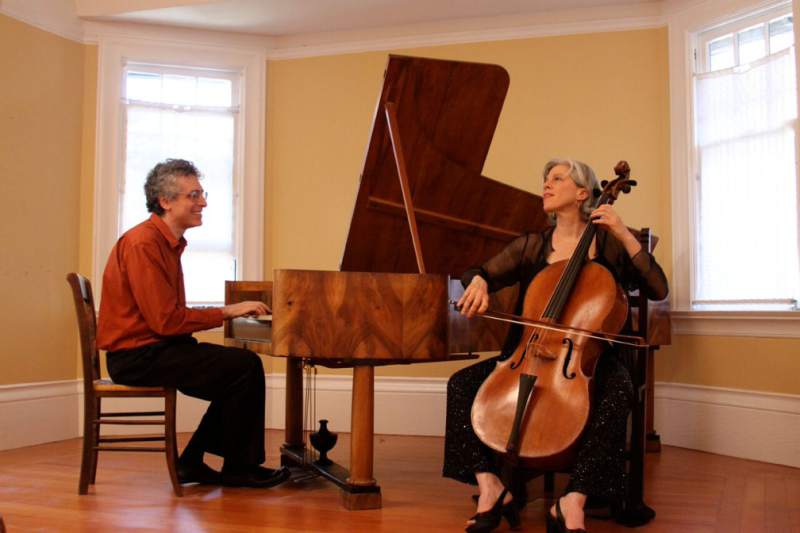|
Symphony
FROM THE NEW WORLD TO THE OLD WORLD
by Peter Lert
Saturday, June 14, 2025
Chamber
MC2 DUO RECITAL CLOSES 222'S SEASON
by Terry McNeill
Saturday, June 14, 2025
Choral and Vocal
CANTIAMO SONOMA'S LUSCIOUS A CAPELLA SINGING IN SEASON ENDING CONCERT
by Pamela Hicks Gailey
Sunday, June 8, 2025
Symphony
SRS SEASON ENDS WITH RESOUNDING TA-TA-TA-BANG
by Terry McNeill
Sunday, June 1, 2025
Symphony
YOUTHFUL VIRTUOSITY ON DISPLAY AT USO'S MAY CONCERTS
by Peter Lert
Saturday, May 17, 2025
Symphony
MYSTICAL PLANETS AND LIVELY GERSHWIN ORTIZ AT FINAL SRS CONCERT
by Peter Lert
Sunday, May 4, 2025
Symphony
VSO'S CONCERT MUSIC OF TIME, MUSIC OF PLACE
by Peter Lert
Sunday, April 27, 2025
VOCAL ELEGANCE AND FIRE AT THE 222'S RECITAL APRIL 26
by Pamela Hicks Gailey
Saturday, April 26, 2025
CANTIAMO SONOMA SINGS AN INSPIRED GOOD FRIDAY MOZART REQUIEM CONCERT
by Pamela Hicks Gailey
Friday, April 18, 2025
DRAMATIC SHOSTAKOVICH SYMPHONY CLOSES PHILHARMONIC'S 25TH SEASON
by Terry McNeill
Sunday, April 13, 2025
|
 |
 Eric Vivian and Tanya Tomkins |
ECLECTIC CELLO PIANO VIRTUAL RECITAL FROM TOMKINS ZIVIAN DUO
by Terry McNeill
Sunday, March 28, 2021
The venerable 41-year Redwood Arts Council Series in Occidental has joined the virtual recital world with low budget but artistically satisfying programs, mostly using videos filmed in the performer’s residences. March 28 saw the Tanya Tomkins-Eric Zivian duo present an eclectic program from their Berkeley studio, the fourth RAC event of the season.
As usual the musical mix was intriguing. Over the recent Beethoven anniversary year Mr. Zivian essayed the 32 Beethoven Sonatas using pianos of the composer’s period, and in this recital he chose the popular D Minor work from Op. 31 (“Tempest”) and caught the mystery in the opening Largo-Allegro’s recitatives. Playing from score and with feet in socks, the pianist made the most of the limited dynamic contrasts available in this fortepiano, albeit aided by amplification.
Tempos throughout were judicious with occasional rolled left-hand chords adding interest, juxtaposed with the piano’s inherent lack of sustain in the many arpeggios. Scale playing was clean in the final Allegretto and the forte descending passage a few bars before the end was played with sprightly two hands rather than in single-hand octaves. A nice touch.
Ms. Tomkins introduced and played a six-minute Offenbach work, Les Larmes de Jacqueline (Jacqueline’s tears), Op. 76, No. 2, with Mr. Zivian. It’s almost always played with orchestra, and here the cellist drew long phrase endings from her instrument, tasteful vibrato and underscored the many modulations. This piece richly wanders about with at times schmaltzy yearning and elegant low register music for the cello. Perhaps this was a North Coast premiere performance?
Mr. Zivian played an 1841 piano (Rausch, made in Odessa) for this work and the following Rubinstein Melodie, Op. 3, No. 1, in the cellist David Popper’s transcription. In the spoken introduction Ms. Tomkins mentioned the cello had two gut strings, and Mr. Zivian clarified that the composer of the Melodie was not the Polish pianist Artur Rubinstein, who did not compose. It’s understandable that this identification is often made, but also sad as Artur was but an important 20th Century pianist, and Anton was the second greatest pianist in history. Most people today would not recognize the once popular Melodie, or even McDowell’s To A Wild Rose. Times have changed. The middle section transition was all Popper, and Ms. Tomkins closed with lovely ascending phrase with a double stop.
Concluding was Beethoven’s D Major Sonata from 1815, Op. 102, No. 2, and Mr. Zivian returned to his 1798 instrument. This quirky work was played that way in the opening Allegro con Brio with many tempo changes and explosive phrasing. Playing from score, Ms. Tomkins playing in the Adagio brought a deep sadness to the slow march, morphing into lyrical sections that were characterized by “luftpause” cessations. The piano line everywhere blended well with the cello.
A complex fugue unfolded in the finale (Allegro), the playful counterpoint impressive where the major interest is mostly with the cello. The ending was stylish, tying up a movement of contrasts so different from the preceding C Major and A Major Beethoven Sonatas. There were charming bits of humor from the playing of both instruments in the final movement.
During the video there were numerous visual dropouts and still frames, but the audio was clear and without distortion. Series producer Sonia Tubridy led a Q and A with the artists following the Sonata.
|

